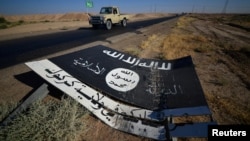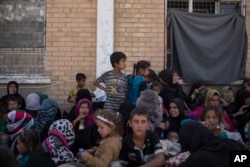The United Nations has warned that many innocent lives could be endangered in the coming days as the Iraqi army and its allied Shi'ite militias continue to press for the last pockets of Islamic State in Hawija and Anbar.
"More people are expected to be displaced in the next 24 to 48 hours as fighting pushes into more densely populated areas," U.N. spokesperson Jens Laerke told reporters in Geneva.
Laerke says an estimated 12,500 civilians have fled their homes in Hawija since the start of the Iraqi operation on September 21, and nearly 78,000 people could still be trapped in their homes as the fighting reaches densely populated areas.
"We remain concerned for the lives and well-being of these vulnerable civilians and remind those doing the fighting that civilians must be protected at all times and allowed to safely leave Hawija," Laerke said in a news conference Tuesday in Geneva.
Hawija is a Sunni-majority city in the al-Hawija district with a population of about 100,000. It had a population of 500,000 before IS took control in mid-2014 as many residents fled the violence.
Iraqi army and allied Shi'ite Popular Mobilization Forces claim the fight for Hawija has entered its final stages as they recently gained a strategic foothold in the district by capturing an air base from IS on Monday. The base, known as Rashad air base, is about 30 kilometers (20 miles) south of Hawija and serves as a training camp and logistic base for IS in the region.
"There remains 500 IS local and foreign fighters in Hawija town based on the information we have," Abu Xalid, a commander of Popular Mobilization Forces, told VOA. "Our sources say they [IS] have prepared 17 suicide vehicles to impede our advances."
More displaced in Anbar
In western Iraq's Anbar province, where the Iraqi army launched a separate offensive last month against IS, the U.N.'s International Organization for Migration said it has identified more than 8,500 newly displaced people, raising the number of displaced in the province to more than 54,000 since January 2017.
The U.N. agency said fleeing civilians have to walk long distances — some for several days, often in intense heat — to reach safe areas. They say most of the newly displaced are children, women and elderly people.
"People newly displaced from their homes often arrive dehydrated, suffering from hunger and thirst," said IOM's Hamed Amro. "Many require psychosocial support and need medical care. Some have chronic illness and exacerbated conditions due to a long-term lack of care, and others suffer from malnutrition. We have also received a few trauma cases."
Commanders on the ground say IS has set fire to oil wells, and has forced civilians who remained to serve as human shields to inhibit airstrikes.









